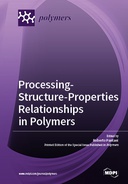Explore

Processing-Structure-Properties Relationships in Polymers
Roberto Pantani
2019
0 Ungluers have
Faved this Work
Login to Fave
This collection of research and review papers is aimed at depicting the state of the art on the possible correlations between processing variables, obtained structure and special properties which this structure induces on the plastic part. The extraordinary capacity of plastics to modify their properties according to a particular structure is evidenced for several transformation processes and for many applications. The final common goal is to take profit of this peculiar capacity of plastics by inducing, through a suitable processing, a specific spatial organization.
This book is included in DOAB.
Why read this book? Have your say.
You must be logged in to comment.
Rights Information
Are you the author or publisher of this work? If so, you can claim it as yours by registering as an Unglue.it rights holder.Downloads
This work has been downloaded 276 times via unglue.it ebook links.
- 210 - pdf (CC BY-NC-ND) at Unglue.it.
Keywords
- 3D printing/additive manufacturing
- atomic force microscopy
- biaxial elongation
- biobased films
- biodegradable nanofibers
- bioresorbable polymers
- bioresorbable vascular scaffolds
- breathable film
- carbon black
- carbon nanotube
- cavitation
- chain orientation
- collagen
- compatibilizer
- composite
- composites
- compression molding
- conductive filler
- conductive polymer composites
- contact angle
- controllable gas permeability
- copper clad laminate
- critical gel
- crystalline morphology
- crystallinity
- crystallisation
- curing rate
- deformation
- degradation
- electrical conductivity
- epinephrine
- epoxy microstructure
- ethylene vinyl acetate
- Fatigue
- flame retardant
- flow
- foam
- fused filament fabrication/fused deposition modelling
- gel
- Graphene
- graphite
- Harmonix AFM
- homogeneous dispersion
- humidity
- hydrophobicity
- in situ X-ray
- incremental forming
- indentation
- injection molding
- intrinsic viscosity
- ionic liquids
- isotactic polypropylene
- layered double hydroxides
- lidocaine
- linear coefficient of thermal expansion (CTE)
- mechanical performance
- Mechanical properties
- melamine polyphosphate
- microcellular injection molding
- microencapsulation
- microfibrillar composites
- Model
- mold temperature evolution
- Morphology
- Nanoparticles
- nanoreinforcement
- octakis[(3-glycidoxypropyl)dimethylsiloxy]octasilsesquioxane (GPOSS)
- Orientation
- phase transitions
- physicochemical characterization
- PLA
- PLGA
- PLLA
- poly(?-caprolactone)
- poly(ethylene terephthalate)
- poly(lactic acid)
- polyamide 6
- polycaprolactone
- polyimide film
- polymer blend
- polymer composite
- polymer morphology
- polymorphism
- polyolefin
- polyoxymethylene (POM)
- polypropylene
- polyurethane
- polyvinyl butyral
- processing
- reactive blending
- SAXS
- shear
- SPIF
- stress-induced phase transitions
- stretch blow molding
- structural analysis
- structure and properties
- supercritical CO2
- supercritical fluid
- supercritical N2
- temperature
- temperature sensitive
- Tissue Engineering and Regenerative Medicine
- ultra-high molecular weight polyethylene
- ultra-high molecular weight polyethylene (UHMWPE)
- uniaxial compression
- uniaxial tensile deformation
- WAXS
- X-ray diffraction
- XRD
Links
DOI: 10.3390/books978-3-03921-881-3Editions


